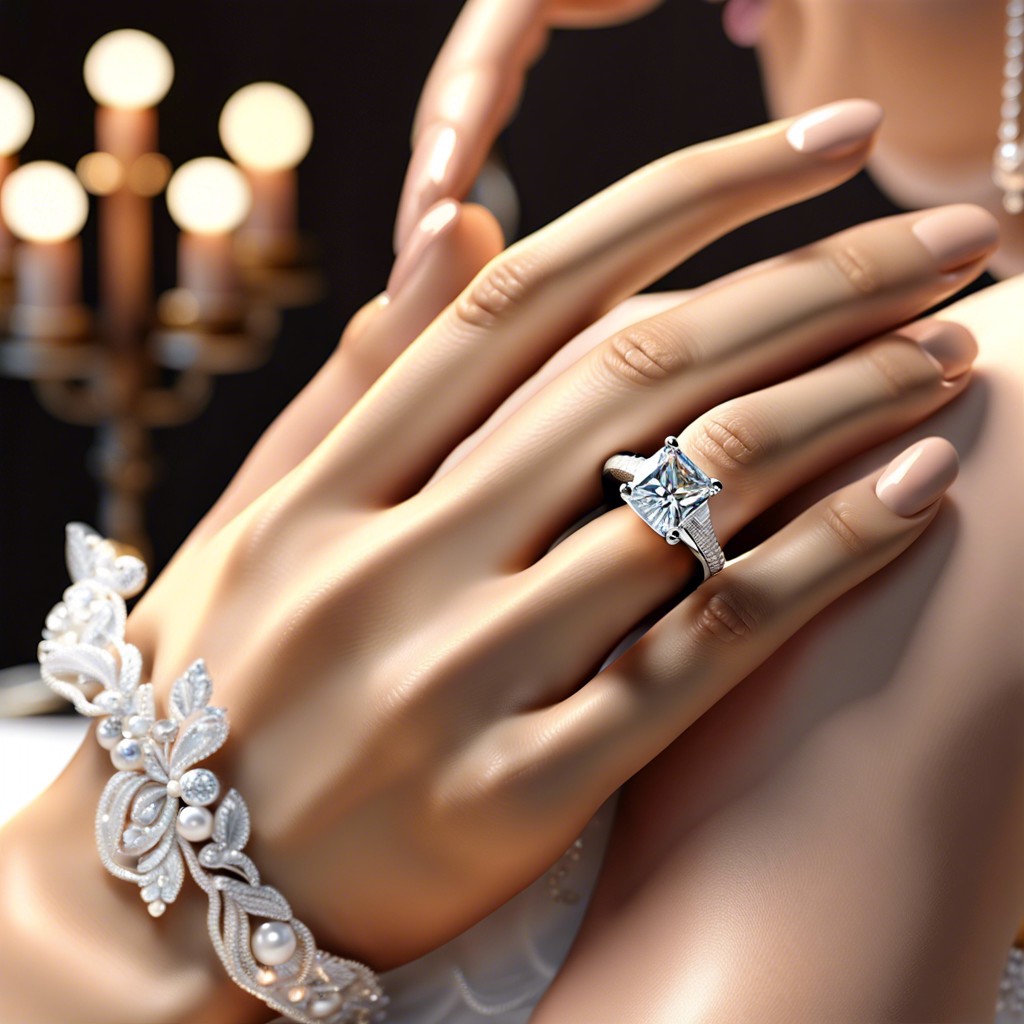In this article, you will learn which hand is traditionally chosen for wearing a wedding ring for females and the symbolism behind it. Traditionally, the wedding ring for females is worn on the fourth finger of the left hand. This custom stems from the ancient Roman belief that the left ring finger houses the “vena amoris,” or vein of love, which was thought to be directly connected to the heart. While this belief has been medically disproven, the tradition continues due to its romantic symbolism and widespread adoption in Western cultures. However, some cultures and individuals may choose the right hand for personal, cultural, or practical reasons. Ultimately, the choice of hand for a wedding ring is a personal preference and can vary based on cultural traditions and individual values.
Key takeaways:
- Wedding ring for females traditionally worn on left hand’s fourth finger.
- Some cultures wear wedding ring on right hand for symbolic reasons.
- Personal preference, comfort, and profession can influence hand choice.
- Left hand tradition stems from ancient Roman belief in the “vein of love.”
- Engagement ring may be moved or stacked with wedding band.
What Hand Does a Wedding Ring Go On?

In many Western cultures, the wedding ring is traditionally worn on the left hand’s fourth finger. This custom can be traced back to the ancient Romans. They believed that this finger housed the “vena amoris,” or the vein of love, which was thought to run directly to the heart, symbolizing love and commitment.
However, not all cultures follow this practice. In some European countries, such as Germany, Russia, and India, it is more common to wear the wedding ring on the right hand. This variation often stems from cultural beliefs or historical practices. For example, in some Orthodox Christian ceremonies, the wedding ring is placed on the right hand to symbolize the “right hand of God.”
The choice of hand and finger for wearing a wedding ring also can be personal. Some people may choose their hand based on comfort, profession, or aesthetic preferences.
Despite the differences in traditions, the significance of the wedding ring as a symbol of marital fidelity and love is universally understood. Whether worn on the left or the right hand, the ring serves as a daily reminder of a person’s commitment to their spouse.
The Wedding Ring Finger Tradition
In many Western cultures, the tradition of wearing a wedding ring on the fourth finger of the left hand stems from ancient Rome. The Romans believed this finger housed the “vena amoris” or “vein of love,” which was thought to be directly connected to the heart. Although modern science shows all fingers have a similar vein structure, the romantic notion has endured, making the left ring finger a symbol of love and commitment.
Other historical influences include Christian customs, where during the marriage ceremony, the ring was placed on the left ring finger in the name of the Father, the Son, and the Holy Spirit, aligning with the holy trinity. With each naming, the ring was touched on the thumb, the first and the second finger, and then placed on the third.
Despite societal changes and varying personal preferences, the left ring finger continues to be the most common choice for wedding rings in many countries. However, this tradition is not universal, and some individuals or couples might choose differently based on their cultural background, profession, or personal comfort.
Wedding Ring Finger Traditions in Other Cultures & Countries
In various cultures, the traditions surrounding the wedding ring finger diverge from the common Western practice of wearing the wedding ring on the left hand. For instance, in many Eastern European and South American countries, the ring is traditionally worn on the right hand. This custom often stems from religious or cultural beliefs. In Orthodox Christian ceremonies, such as those in Greece and Russia, the right hand symbolizes honor and trust, making it the chosen hand for wedding bands.
Meanwhile, in India, the left hand was once considered inauspicious, so wedding rings were worn on the right. However, this has been changing with Western influence, and left-handed ring wearing is becoming more prevalent. Alternatively, some brides in India wear their wedding rings on a chain around their neck.
Jewish couples often place the wedding ring on the index finger of the right hand during the ceremony, linking to ancient beliefs that this finger directly connected to the heart. After the ceremony, however, the ring may be moved to another finger, including the ring finger of the left hand, more in line with Western tradition.
In some cultures, wedding rings are not part of the marriage tradition at all, with other tokens of marital commitment taking their place. These practices highlight the beautiful diversity in marital symbolism across the globe.
What Order Do You Wear Rings On Your Ring Finger?
Traditionally, the engagement ring is presented at the proposal and later joined by the wedding band. During the wedding ceremony, the engagement ring is either switched to the right hand or moved up the left ring finger to make room for the wedding band. This allows the wedding band, which is typically simpler in design, to be placed on the ring finger first, closer to the heart. After the ceremony, the engagement ring is often placed back on top of the wedding band, creating a stack.
Some choose to solder their engagement and wedding rings together after the wedding, creating a single piece of jewelry that symbolizes their union. This can simplify daily wear and maintain the position of the rings. Others wear only the wedding band on a daily basis for practical reasons, reserving the engagement ring for special occasions.
Remember that these practices can vary, and some might prefer a non-traditional order or choose to wear their rings on different fingers altogether. Personal preference and symbolism unique to one’s relationship can dictate the order of rings.



